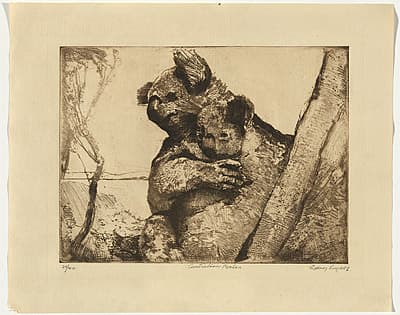
Sydney
LONG
Australia
1871
–
London
1955
England, Europe 1910-21; Australia 1921- 22; England 1922-25; Australia 1925-52; England from 1952
18.8 (h) x 25.2 (w) cm
20/100 , published state , edition of 100
Signed lower right below plate-mark in black pencil, 'Sydney Long ARE.' Titled lower centre below plate-mark in black pencil, 'Australian Koalas'. Inscribed with edition details lower left below plate-mark in black pencil, '20/100'. National Gallery of Australia, Canberra NGA 2011.1312 Purchased 2011.
- Purchased by the National Gallery of Australia, from Gallery Savah, Sydney, October 2011.
Long made several etchings of koalas, and this work is an especially sentimental portrayal, in which a mother clutches her small joey protectively. Aside from any interest Long may have had in the welfare
of the animal, the popularity of etching at this
time was in decline, and the subject would have been a saleable one.
The etching may be contemplated within the context of the nationalism that emerged in the wake of Federation. Whereas earlier generations of European-Australians had considered native animals as oddities, Long’s peers regarded them with affection. Koala motifs began appearing with increasing frequency as the century progressed – and not only in prints. They were cut in stone as architectural decoration, cast in pale glazes by potters and they inhabited books and magazines.
In the early 20th century, koala pelt was a profitable export commodity, coveted for its softness and exoticism. By 1927, however, the animal was close to extinction and public outcry in Australia became widespread and impassioned. Newspaper reports condemned the indiscriminate slaughter of koalas during ‘open season’ in the Queensland bush. Further opposition arose in the form of petitions, lectures and poetic laments. On
28 July 1927 the Brisbane Courier published a dirge composed from the perspective of the animal itself, in which it asked how it had ‘stirred the white man’s wrath’, and recounted the sad farewell, bade to it by forests of
blue gums.
Elspeth Pitt
Long made several etchings of koalas, and this work is an especially sentimental portrayal, in which a mother clutches her small joey protectively. Aside from any interest Long may have had in the welfare
of the animal, the popularity of etching at this
time was in decline, and the subject would have been a saleable one.
The etching may be contemplated within the context of the nationalism that emerged in the wake of Federation. Whereas earlier generations of European-Australians had considered native animals as oddities, Long’s peers regarded them with affection. Koala motifs began appearing with increasing frequency as the century progressed – and not only in prints. They were cut in stone as architectural decoration, cast in pale glazes by potters and they inhabited books and magazines.
In the early 20th century, koala pelt was a profitable export commodity, coveted for its softness and exoticism. By 1927, however, the animal was close to extinction and public outcry in Australia became widespread and impassioned. Newspaper reports condemned the indiscriminate slaughter of koalas during ‘open season’ in the Queensland bush. Further opposition arose in the form of petitions, lectures and poetic laments. On
28 July 1927 the Brisbane Courier published a dirge composed from the perspective of the animal itself, in which it asked how it had ‘stirred the white man’s wrath’, and recounted the sad farewell, bade to it by forests of
blue gums.
Elspeth Pitt
Long made several etchings of koalas, and this work is an especially sentimental portrayal, in which a mother clutches her small joey protectively. Aside from any interest Long may have had in the welfare
of the animal, the popularity of etching at this
time was in decline, and the subject would have been a saleable one.
The etching may be contemplated within the context of the nationalism that emerged in the wake of Federation. Whereas earlier generations of European-Australians had considered native animals as oddities, Long’s peers regarded them with affection. Koala motifs began appearing with increasing frequency as the century progressed – and not only in prints. They were cut in stone as architectural decoration, cast in pale glazes by potters and they inhabited books and magazines.
In the early 20th century, koala pelt was a profitable export commodity, coveted for its softness and exoticism. By 1927, however, the animal was close to extinction and public outcry in Australia became widespread and impassioned. Newspaper reports condemned the indiscriminate slaughter of koalas during ‘open season’ in the Queensland bush. Further opposition arose in the form of petitions, lectures and poetic laments. On
28 July 1927 the Brisbane Courier published a dirge composed from the perspective of the animal itself, in which it asked how it had ‘stirred the white man’s wrath’, and recounted the sad farewell, bade to it by forests of
blue gums.
Elspeth Pitt
